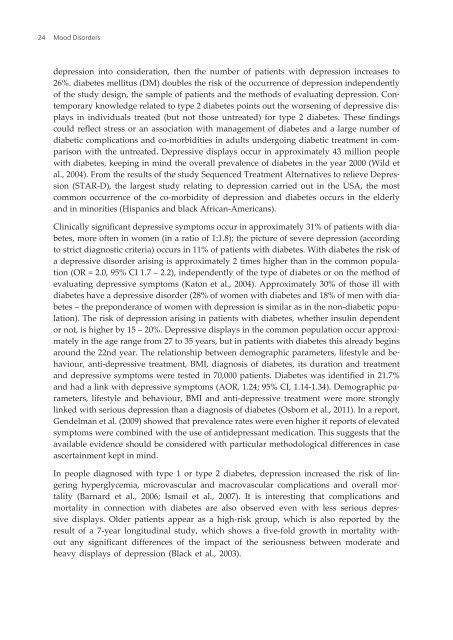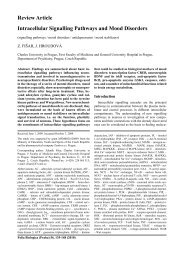MOOD DISORDERS
MOOD DISORDERS
MOOD DISORDERS
You also want an ePaper? Increase the reach of your titles
YUMPU automatically turns print PDFs into web optimized ePapers that Google loves.
24<br />
Mood Disorders<br />
depression into consideration, then the number of patients with depression increases to<br />
26%. diabetes mellitus (DM) doubles the risk of the occurrence of depression independently<br />
of the study design, the sample of patients and the methods of evaluating depression. Con‐<br />
temporary knowledge related to type 2 diabetes points out the worsening of depressive dis‐<br />
plays in individuals treated (but not those untreated) for type 2 diabetes. These findings<br />
could reflect stress or an association with management of diabetes and a large number of<br />
diabetic complications and co-morbidities in adults undergoing diabetic treatment in com‐<br />
parison with the untreated. Depressive displays occur in approximately 43 million people<br />
with diabetes, keeping in mind the overall prevalence of diabetes in the year 2000 (Wild et<br />
al., 2004). From the results of the study Sequenced Treatment Alternatives to relieve Depres‐<br />
sion (STAR-D), the largest study relating to depression carried out in the USA, the most<br />
common occurrence of the co-morbidity of depression and diabetes occurs in the elderly<br />
and in minorities (Hispanics and black African-Americans).<br />
Clinically significant depressive symptoms occur in approximately 31% of patients with dia‐<br />
betes, more often in women (in a ratio of 1:1.8); the picture of severe depression (according<br />
to strict diagnostic criteria) occurs in 11% of patients with diabetes. With diabetes the risk of<br />
a depressive disorder arising is approximately 2 times higher than in the common popula‐<br />
tion (OR = 2.0, 95% CI 1.7 – 2.2), independently of the type of diabetes or on the method of<br />
evaluating depressive symptoms (Katon et al., 2004). Approximately 30% of those ill with<br />
diabetes have a depressive disorder (28% of women with diabetes and 18% of men with dia‐<br />
betes – the preponderance of women with depression is similar as in the non-diabetic popu‐<br />
lation). The risk of depression arising in patients with diabetes, whether insulin dependent<br />
or not, is higher by 15 – 20%. Depressive displays in the common population occur approxi‐<br />
mately in the age range from 27 to 35 years, but in patients with diabetes this already begins<br />
around the 22nd year. The relationship between demographic parameters, lifestyle and be‐<br />
haviour, anti-depressive treatment, BMI, diagnosis of diabetes, its duration and treatment<br />
and depressive symptoms were tested in 70,000 patients. Diabetes was identified in 21.7%<br />
and had a link with depressive symptoms (AOR, 1.24; 95% CI, 1.14-1.34). Demographic pa‐<br />
rameters, lifestyle and behaviour, BMI and anti-depressive treatment were more strongly<br />
linked with serious depression than a diagnosis of diabetes (Osborn et al., 2011). In a report,<br />
Gendelman et al. (2009) showed that prevalence rates were even higher if reports of elevated<br />
symptoms were combined with the use of antidepressant medication. This suggests that the<br />
available evidence should be considered with particular methodological differences in case<br />
ascertainment kept in mind.<br />
In people diagnosed with type 1 or type 2 diabetes, depression increased the risk of lin‐<br />
gering hyperglycemia, microvascular and macrovascular complications and overall mor‐<br />
tality (Barnard et al., 2006; Ismail et al., 2007). It is interesting that complications and<br />
mortality in connection with diabetes are also observed even with less serious depres‐<br />
sive displays. Older patients appear as a high-risk group, which is also reported by the<br />
result of a 7-year longitudinal study, which shows a five-fold growth in mortality with‐<br />
out any significant differences of the impact of the seriousness between moderate and<br />
heavy displays of depression (Black et al., 2003).






